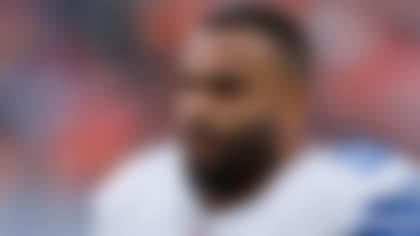When Charley Casserly was the general manager of the Washington Redskins a few decades ago, head coach Joe Gibbs constantly would remind the personnel department of his pecking order.
The most important player on any team is the quarterback. The second-most important player? The backup quarterback.
Gibbs' words ring especially true this week. The Patriots appear ready to start third-string quarterback Jacoby Brissett (the 91st overall pick in this past April's NFL draft) against the Texans on "Thursday Night Football," while the Browns are in line to start third-stringer Cody Kessler (the 93rd pick in April's draft) against the Dolphins in Miami. Meanwhile, the Bears are facing at least a couple weeks without Jay Cutler, who sprained his right thumb in Monday night's loss to Philadelphia. Brian Hoyer was the only other QB on Chicago's active roster when Cutler went down, with Matt Barkley on the practice squad.
It's only mid-September, but all three of these teams already are dealing with serious turmoil at the all-important quarterback spot, forcing each front office to comb the familiar yet unsavory options available to clubs locked in the young season's grind. Do you add a veteran? How do you alter the playbook?
Replacing a starting quarterback is an event that affects everyone in the organization, from the general manager down to the position coach. So, in that spirit, NFL.com is recreating the act with the help of some men who've been through it before.
From emotional support and leadership to practice alterations and schedule changes, no one's week goes uninterrupted.
The front office
They used to call it the 911 list. In case of emergency only.
The list, in Casserly's GM days, was first compiled before training camp. During the preseason, members of the team's pro and college scouting department would rank all 90 members of each opposing team's roster. Then they would concentrate on the guys ranked from 26 to 90 -- a team isn't likely to cut one of its best 25 players during roster downsizing -- and compile a report. Following the final cutdown day, personnel staffers would meet again, take their reports and re-rank all available bodies from best to worst option, sorted by position. The club would then take every team's practice squad -- the next wave of players most likely to get cut -- and rank a third time. (Some clubs, according to multiple people with knowledge of the situation, go a step further and rank players who are on teams' game day inactive lists because they would theoretically be the next group on the chopping block.)
"So now we have a list at every position," Casserly told me this week. "Now, it varies, it varies on ability. Sometimes you would have two quarterbacks and five tight ends because every player has a grade, and we cut [the list] off at a certain grade level.
"Every Friday, we meet and review the week with the pro scouts. You're talking to your head coach every single day you're in the office and you're making sure you are on the same page. The goal is to understand how every player on your roster gets there. You've already talked about this guy. You've already evaluated this guy."
After Friday's powwow with the head coach and pro personnel meeting, Casserly would then go back through his 53-man roster and compile an action plan in case of injury for every single person on the roster so that Sunday would be a little less stressful.
And still, there was little solace. The odds decrease with each day into the season that the given player is still in tip-top shape. If a key cog was indeed lost, the head coach and Casserly's personnel department would meet after the game, discuss the top three options -- never more, as a coach doesn't have the time (or typically the desire) to sit through a lengthy meeting after a game -- and start making calls.
"The people who don't need to be in the room aren't in the room," Casserly said.
Of course, time is of the essence when you're looking to bring in a player and get him up to speed on the scheme (as much as possible) before the following week's game. And this is especially true with quarterbacks.
The Browns almost immediately pounced on Charlie Whitehurst, adding the journeyman backup on Monday night. On the other hand, the Patriots, who have a short week before their "Thursday Night Football" bout, appear poised to ride with what they already have -- and could get a little creative. Ailing QB Jimmy Garoppolo, whose sprained AC joint forced Brissett into action, was listed as limited in Tuesday's practice, and there's a chance he's healthy enough to dress and back up the rookie. Even more interesting: NFL Network Insider Ian Rapoport reported Wednesday that New England has done extensive preparation over the past few days to get wide receiver Julian Edelman -- who played quarterback at Kent State -- up to speed for a potential QB2 role. At publishing, the Bears have yet to clarify their plan going forward, but Barkley could be moving from the practice squad to the 53-man roster.
With how crucial the quarterback position is to each and every team in today's game, this fire drill is never easy. But it's a circumstance everyone must prepare for.
The head coach
Former New York Giants head coach Jim Fassel believed that his most important work with an emergency QB was on Friday, or the final day of game plan installation.
In a private meeting inside his office, Fassel would lay out the entire call sheet, which was separated with boxes into different scenarios -- third-and-7-to-10, first-and-10, second-and-5-or-less -- and allow his quarterback to customize the sheet based on comfort level and knowledge.
"I just tell them, 'Scratch any play you don't feel comfortable with,' " Fassel explained to me this week. "Some of those plays, he's not had any reps on. He will have had some experience with other ones. The bottom line is, let him get rid of any play he's not comfortable with because I only want to use plays he's familiar with. Maybe he hasn't thrown an 82 double seam for weeks and weeks with the starting guys."
Fassel believed the benefit of a shortened playbook outweighed the nerves that come with forcing the starter to prepare for everything.
"I always had way more calls on the call sheet than I was going to use in the game anyway," Fassel said. "So cutting it back, you're not really limiting yourself to where the other offensive players are worried about the size of the game plan. You're still going to have plenty of plays. There's nothing wrong with repeating plays.
"I've seen that happen sometimes. Young guys worried about calling the same play in a game twice. I'm like 'What? If it works, call it again.' "
After the quarterback crossed out all the plays he was uncomfortable with, Fassel would go back through the same list again. This time, he wanted the quarterback to rank the remaining plays in terms of his confidence in execution.
"Let him have ownership over it," Fassel said. "We'll talk about it all. This isn't going to be a five-minute meeting."
During the week, it was all about improving the mentality of the team.
On the field, that meant never wasting a single repetition. Off the field, that meant tailoring a message to the individual, the other 52 players and to the press. When asked by the media, Fassel remembered being relentlessly upbeat about his backups -- to a point.
"Just don't make it sound like you have the next John Elway," he said.
During team meetings, he pointed to every other position group and asked them to shoulder a little bit more of the burden. To the quarterback, it was always, "You can do this."
In many ways, the most important forum for positivity was the first team meeting after the situation became clear, when everyone knew the starter was down. Fassel kept it simple.
"Oh, and there was a guy named Tom Brady, a sixth-round draft choice who hardly ever played and they went on to win the Super Bowl," he remembered saying to the Giants on multiple occasions following New England's Super Bowl run in 2001. "That Patriots team played great defense and won the turnover battle. It doesn't take a genius to do that."
The coordinator and position coach
The 2011 collective bargaining agreement decreased practice and meeting time, and the fallout from this is never felt more than when a seldom-used backup quarterback is pressed into service.
Former Giants offensive coordinator and longtime NFL coach Kevin Gilbride never had this issue with Eli Manning, who sits atop the NFL's active list of most consecutive games played (185). Then again, he considered that penance for a laundry list of backups he had to cram with over the years as a head coach in San Diego and offensive coordinator in Houston, Jacksonville, Pittsburgh and Buffalo. Each name -- Cody Carlson, Bucky Richardson, Jim Everett, Mike Tomczak -- elicits a unique memory.
"I think the anxiety level heightens," Gilbride said. "And whenever you rob Peter to pay Paul -- taking time from your normal routine to spend extra time with one player -- then you have to make up for it somehow. And that means you're cutting into your sleep time at the end of the day."
At the coordinator and position coach level, you are the first to find out how well your backups actually have been studying the playbook -- and how smart your new veteran arm actually is. Gilbride said he ran into numerous situations over the years where some of his backups who had been with the team during the preseason still failed to grasp the team's concepts offensively. Unfortunately, they could not hide any longer.
"Hopefully they're putting in the time this week, so they're ready to go," Gilbride said, laughing.
That's because the nature of the meeting changes. If a coordinator is giving a meeting to his entire offense, it's more of a passive learning environment than an active one. Players need to listen, not respond. When preparing a new signal caller, that changes to an active meeting style -- especially once quarterbacks break off from the rest of the offense and meet again.
"Now I'll say, 'What did you see here?' " Gilbride described. " 'Explain what you're looking at. Explain to me what he's doing. Based on what you're doing, where should the ball have gone? Do you throw the next read?' "
When Gilbride coached Manning, he had the luxury of doing this with the backups on a daily basis because he already knew that Manning had the answers. That being said, the team never gave a backup reps with the first string during practice, which added to the stress Gilbride felt every time Manning was on the ground, slow to get up.
And maybe that's the point of all this. The process is complex and multi-layered. It takes hundreds of hours of legwork, dozens of meetings and seamless collaboration between the front office and the coaching staff. Yet the minute the game starts, all that theory is blown out the window. The other team has had just as long to prepare.
Congratulations. You've gotten your new quarterback to game day. The rest is up to the universe.
"When the bullets are live and they're trying to take your head off, that's a whole 'nother ball of wax," Gilbride said.











